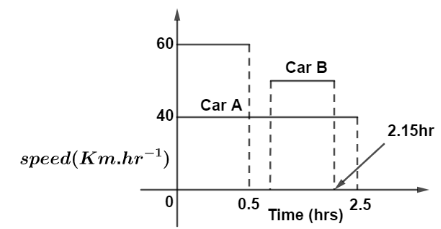Question
Question: Car A and B travels \(100\,km\) journey together. Car A travels with uniform speed of \(40\,kmh{r^{ ...
Car A and B travels 100km journey together. Car A travels with uniform speed of 40kmhr−1 and Car B travels with 60kmhr−1 but after half an hour it stops for 15min due to some problems and when it moves its speed remains 50kmhr−1
(a) Draw a speed time graph of journey
(b) Tell which car will complete the journey first and how much time before?
Solution
In order to solve this question we need to understand the difference between speed and velocity. Speed is a scalar quantity and it is mathematically defined as total distance covered per unit time whereas velocity is a vector quantity so it is defined as speed having some particular direction. Since speed is scalar quantity so two different speeds can be added linearly whereas velocity is a vector and two velocities can be added using the rule of vector addition.
Complete step by step answer:
Given the problem, Total journey distance is d=100km.
Speed of a car A throughout the journey is v1=40kmhr−1.
Let Speed of car B up to distance d2 is v2=60kmhr−1 in half hour and after 15min speed to cover rest distance is v3=50kmhr−1.
(a) Speed time journey can be drawn as:

(b) Let the time taken by car A be t1.
Therefore from definition of speed is, v=td
For Car A v1=t1d1
Putting values we get t1=40100hr
t1=2.5hr
For Car B, distance up to speed is 60kmhr−1 be d2 Since time taken to cover this distance is t=0.5hr
Therefore, distance d2 is given by v2=td2 or
d2=v2×t
Putting values we get d2=60kmhr−1×0.5hr or
d2=30km
So distance left to cover for car B is d3=100−d2 Putting values we get
d3=(100−30)km Or
⇒d3=70km
Since car B travels rest distance with speed v3 let the time taken to travel this distance be t2
So from speed formula we get v3=t2d3 or
t2=v3d3
Putting values we get
t3=5070hr
⇒t3=1.4hr
So total time taken for car B to travel distance is t′=(t+(0.25)+t2)hr
Here 0.25hr is time that car B stops
So Putting values we get
t′=(0.5+0.25+1.4)hr
⇒t′=2.15hr
So Car A travels in time t1=2.5hr and Car B travels in time t′=2.15hr. So Car B travels faster than Car A. It reaches its destination earlier by (2.5−2.15)hr=0.35hr.
Note: It should be remembered that we have considered here only translation motion not rotatory or any other. Translatory motion is defined as motion confined to only in one dimension, also known as straight line motion, so a force acting on the body in a straight line would either push or pull the body in the same dimension.
